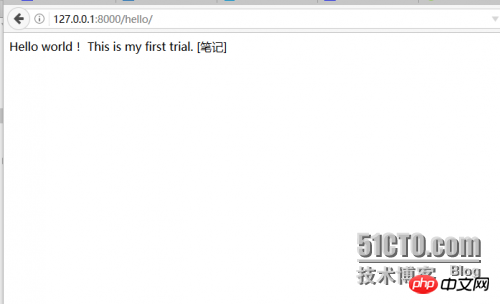这篇文章详解python在pychram中利用djingo开发helloword
首先安装pycheam,python,djingo。
在pychram中新建一个djingo项目

在web2目录下新建views.py文件,目录如下:

接下来在views.py文件中编写helloworld代码:
# -*- coding: utf-8 -*
from django.http import HttpResponse
def hello(request):
return HttpResponse("Hello world! This is my first trial. [笔记]")还需要配置urls.py文件完成映射
from django.conf.urls import patterns, include, url
from web2.views import hello
from django.contrib import admin
from django.conf.urls import *
admin.autodiscover()
urlpatterns = patterns('',
# Examples:
# url(r'^$', 'web2.views.home', name='home'),
# url(r'^blog/', include('blog.urls')),
url(r'^admin/', include(admin.site.urls)),
('^hello/$', hello),
)一定要先导入hello
from web2.views import hello
然后启动项目,在浏览器打开
http://127.0.0.1:8000/hello/

以上是详解python在pychram中利用djingo开发helloword的详细内容。更多信息请关注PHP中文网其他相关文章!
 如何使用Python查找文本文件的ZIPF分布Mar 05, 2025 am 09:58 AM
如何使用Python查找文本文件的ZIPF分布Mar 05, 2025 am 09:58 AM本教程演示如何使用Python处理Zipf定律这一统计概念,并展示Python在处理该定律时读取和排序大型文本文件的效率。 您可能想知道Zipf分布这个术语是什么意思。要理解这个术语,我们首先需要定义Zipf定律。别担心,我会尽量简化说明。 Zipf定律 Zipf定律简单来说就是:在一个大型自然语言语料库中,最频繁出现的词的出现频率大约是第二频繁词的两倍,是第三频繁词的三倍,是第四频繁词的四倍,以此类推。 让我们来看一个例子。如果您查看美国英语的Brown语料库,您会注意到最频繁出现的词是“th
 我如何使用美丽的汤来解析HTML?Mar 10, 2025 pm 06:54 PM
我如何使用美丽的汤来解析HTML?Mar 10, 2025 pm 06:54 PM本文解释了如何使用美丽的汤库来解析html。 它详细介绍了常见方法,例如find(),find_all(),select()和get_text(),以用于数据提取,处理不同的HTML结构和错误以及替代方案(SEL)
 python中的图像过滤Mar 03, 2025 am 09:44 AM
python中的图像过滤Mar 03, 2025 am 09:44 AM处理嘈杂的图像是一个常见的问题,尤其是手机或低分辨率摄像头照片。 本教程使用OpenCV探索Python中的图像过滤技术来解决此问题。 图像过滤:功能强大的工具 图像过滤器
 Python中的平行和并发编程简介Mar 03, 2025 am 10:32 AM
Python中的平行和并发编程简介Mar 03, 2025 am 10:32 AMPython是数据科学和处理的最爱,为高性能计算提供了丰富的生态系统。但是,Python中的并行编程提出了独特的挑战。本教程探讨了这些挑战,重点是全球解释
 如何使用TensorFlow或Pytorch进行深度学习?Mar 10, 2025 pm 06:52 PM
如何使用TensorFlow或Pytorch进行深度学习?Mar 10, 2025 pm 06:52 PM本文比较了Tensorflow和Pytorch的深度学习。 它详细介绍了所涉及的步骤:数据准备,模型构建,培训,评估和部署。 框架之间的关键差异,特别是关于计算刻度的
 如何在Python中实现自己的数据结构Mar 03, 2025 am 09:28 AM
如何在Python中实现自己的数据结构Mar 03, 2025 am 09:28 AM本教程演示了在Python 3中创建自定义管道数据结构,利用类和操作员超载以增强功能。 管道的灵活性在于它能够将一系列函数应用于数据集的能力,GE
 python对象的序列化和避难所化:第1部分Mar 08, 2025 am 09:39 AM
python对象的序列化和避难所化:第1部分Mar 08, 2025 am 09:39 AMPython 对象的序列化和反序列化是任何非平凡程序的关键方面。如果您将某些内容保存到 Python 文件中,如果您读取配置文件,或者如果您响应 HTTP 请求,您都会进行对象序列化和反序列化。 从某种意义上说,序列化和反序列化是世界上最无聊的事情。谁会在乎所有这些格式和协议?您想持久化或流式传输一些 Python 对象,并在以后完整地取回它们。 这是一种在概念层面上看待世界的好方法。但是,在实际层面上,您选择的序列化方案、格式或协议可能会决定程序运行的速度、安全性、维护状态的自由度以及与其他系
 Python中的数学模块:统计Mar 09, 2025 am 11:40 AM
Python中的数学模块:统计Mar 09, 2025 am 11:40 AMPython的statistics模块提供强大的数据统计分析功能,帮助我们快速理解数据整体特征,例如生物统计学和商业分析等领域。无需逐个查看数据点,只需查看均值或方差等统计量,即可发现原始数据中可能被忽略的趋势和特征,并更轻松、有效地比较大型数据集。 本教程将介绍如何计算平均值和衡量数据集的离散程度。除非另有说明,本模块中的所有函数都支持使用mean()函数计算平均值,而非简单的求和平均。 也可使用浮点数。 import random import statistics from fracti


热AI工具

Undresser.AI Undress
人工智能驱动的应用程序,用于创建逼真的裸体照片

AI Clothes Remover
用于从照片中去除衣服的在线人工智能工具。

Undress AI Tool
免费脱衣服图片

Clothoff.io
AI脱衣机

AI Hentai Generator
免费生成ai无尽的。

热门文章

热工具

EditPlus 中文破解版
体积小,语法高亮,不支持代码提示功能

安全考试浏览器
Safe Exam Browser是一个安全的浏览器环境,用于安全地进行在线考试。该软件将任何计算机变成一个安全的工作站。它控制对任何实用工具的访问,并防止学生使用未经授权的资源。

螳螂BT
Mantis是一个易于部署的基于Web的缺陷跟踪工具,用于帮助产品缺陷跟踪。它需要PHP、MySQL和一个Web服务器。请查看我们的演示和托管服务。

SublimeText3 英文版
推荐:为Win版本,支持代码提示!

SublimeText3 Mac版
神级代码编辑软件(SublimeText3)





